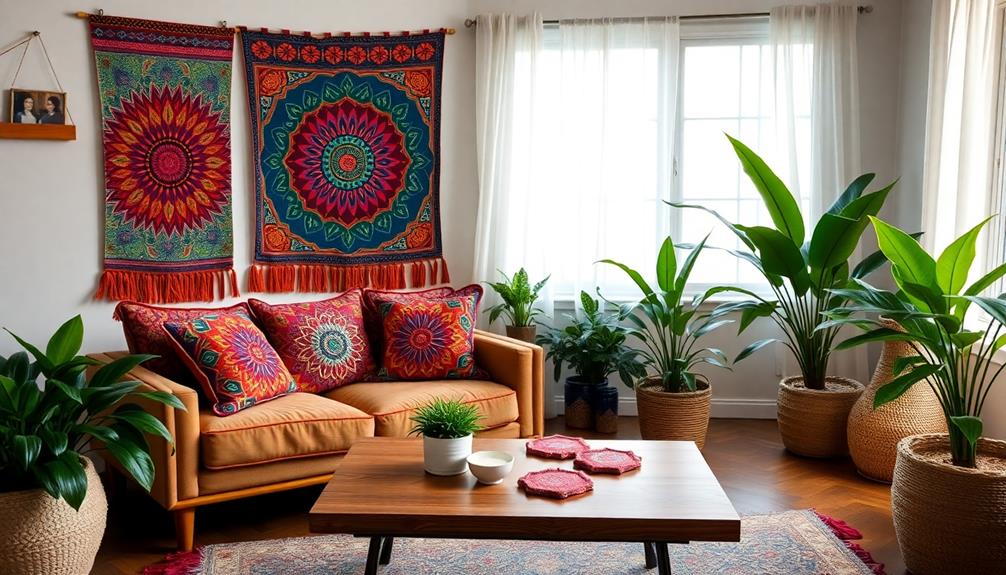Batik can instantly elevate your home, turning it into a canvas of modern artistry. You can incorporate vibrant batik cushions, lampshades, or wall art to create stunning focal points. The intricate patterns and rich colors add depth and cultural significance to your space. Mix batik pieces with solid colors for a balanced look, or use them to express your personal style through DIY projects. Each batik item brings not just beauty but also storytelling elements from Indonesian heritage. Interested in discovering more ways to transform your home with batik? You're just getting started!
Key Takeaways
- Batik fabric features intricate patterns that add cultural depth and aesthetic appeal to modern home decor.
- Incorporating batik textiles in throw pillows and lampshades enhances living spaces with vibrant colors and unique designs.
- Batik wall art serves as a stunning focal point, celebrating traditional artistry while complementing contemporary interiors.
- DIY projects using batik allow for personalized home accessories, merging creativity with cultural heritage.
- The fusion of traditional batik techniques with modern design trends revitalizes spaces, creating a harmonious blend of old and new.
Understanding Batik Fabric

Batik fabric is a stunning example of artistry and tradition, created through a unique wax-resist dyeing technique. This method involves applying hot wax to fabric, which forms intricate patterns that resist dye. Once the dyeing process is complete, the wax is removed, revealing detailed designs that showcase the skill and creativity of the artisan.
Additionally, batik fabric can beautifully complement various decor styles, including the vibrant artistry found in Indonesian decor masks, enhancing the overall aesthetic of your home.
Originating from Java, Indonesia, batik embodies rich cultural heritage and has been recognized by UNESCO as a Masterpiece of Oral and Intangible Heritage. You'll find various types of batik, including Batik Tulis (hand-drawn), Batik Cap (stamped), and Batik Lukis (painted). Each type reflects different levels of intricacy and production methods, making every piece unique.
Traditional batik patterns often symbolize social status, cultural stories, or specific narratives, with certain designs reserved for special occasions such as weddings or royal events.
The materials used typically consist of high-quality textiles and natural dyes, though modern advancements now include synthetic dyes and innovative techniques. By understanding batik fabric, you can appreciate not only its beauty but also the cultural significance that makes it a timeless choice for home decor.
Cultural Significance of Batik

How does a piece of fabric carry centuries of tradition? Batik, originating from Java, Indonesia, is more than just a beautiful textile; it's a reflection of rich cultural significance. Recognized by UNESCO as a Masterpiece of Oral and Intangible Heritage, Batik Fabrics embody stories and values passed down through generations.
Each traditional motif holds deep meanings, from social status to nature, and some designs are specifically reserved for royal ceremonies. This connection to history is essential as you consider how Batik can transform your home.
| Traditional Motifs | Cultural Significance |
|---|---|
| Parang | Symbolizes victory |
| Truntum | Represents love |
| Kawung | Signifies purity |
| Mega Mendung | Denotes protection |
The Art of Batik Creation

In the art of batik creation, you'll explore the traditional wax-resist technique that forms the backbone of this craft, allowing for stunning patterns to emerge.
This technique is similar to the intricate designs found in Indonesian Decor Masks, highlighting the rich cultural heritage that can be incorporated into your home.
As you experiment with contemporary design innovations, you can blend age-old methods with modern aesthetics.
This fusion opens up exciting possibilities for your home decor, ensuring each piece is truly unique.
Traditional Wax-Resist Technique
The traditional wax-resist technique is a fascinating method that transforms plain fabric into stunning works of art. By applying hot wax to specific areas of the fabric, you create barriers that prevent dye from penetrating those sections during the dyeing process. This allows intricate designs to emerge, showcasing batik features like vibrant colors and detailed geometric patterns.
This technique aligns beautifully with the aesthetic of Indonesian decorative pillows, where vibrant colors and intricate patterns enhance living spaces.
The process involves essential tools such as the canting, a small handheld tool for detailed wax application, and copper stamps called caps, which facilitate the mass production of uniform patterns. Traditionally, natural dyes sourced from plants and indigo were used to achieve rich hues, though modern techniques now include synthetic dyes for a wider color palette.
Creating batik pieces is labor-intensive and requires significant skill. Hand-drawn batik (batik tulis) takes more time and is generally more costly due to its intricate detail, while stamped batik (batik cap) allows for quicker production.
Many artisans and groups, like the Batik Guild, keep this rich tradition alive, ensuring that the beauty of traditional batik continues to thrive in contemporary design.
Contemporary Design Innovations
Batik creation has embraced contemporary design innovations that breathe new life into this age-old art form. By merging traditional techniques with modern aesthetics, batik now offers a fresh perspective for interior design.
You'll find that contemporary batik designs showcase vibrant colors and intricate patterns that can transform any space. These designs can beautifully complement traditional Indonesian style home decor, enhancing the overall ambiance with their unique craftsmanship and cultural significance.
Here are some key elements of these innovations:
- Versatile Applications: Batik is no longer limited to clothing; it's now a popular choice for home decor, including wall hangings, cushions, and table linens.
- Unique Craftsmanship: Batik Tulis, with its hand-drawn precision, creates one-of-a-kind pieces that reflect individual artistry, allowing you to showcase your personal style.
- Modern Materials: Contemporary practices have expanded dyeing methods, incorporating synthetic dyes for an extensive color palette while maintaining the integrity of traditional wax-resist techniques.
With these innovations, you can easily incorporate batik into your home, creating a modern masterpiece that celebrates both heritage and creativity.
The blend of traditional craftsmanship and contemporary flair makes batik a perfect choice for anyone looking to enhance their living space.
Incorporating Batik in Home Decor

Adding batik to your home decor can instantly elevate the aesthetic of any space. The beauty of batik lies in its intricate designs and vibrant colors, making it a perfect choice for accent pieces. You can incorporate batik fabric in various forms, such as throw pillows, table runners, or curtains. These elements add cultural richness and artistic flair to your rooms.
Here's a quick guide on how to use batik effectively in your decor:
| Item | Description | Tips |
|---|---|---|
| Throw Pillows | Use batik fabric to create stunning accents | Mix with solid colors for balance |
| Lampshades | Transform lighting fixtures with batik covers | Choose light colors for a warm glow |
| DIY Projects | Create custom storage boxes or coasters | Personalize with unique designs |
Mixing batik clothing with solid textures can create dynamic combinations that enhance your home's overall look. Whether you're using batik as part of your decor or in DIY projects, you're sure to enjoy the wide range of possibilities that this traditional textile offers.
Batik as Wall Art

Batik as wall art brings a unique aesthetic appeal to your space, showcasing vibrant colors and intricate designs.
Each piece tells a story, reflecting cultural significance that enriches your home's decor. Incorporating elements of Indonesian cultural heritage through batik not only enhances your interiors but also celebrates traditional artistry.
Unique Aesthetic Appeal
With its intricate designs and vibrant colors, batik wall art offers a unique aesthetic appeal that transforms any room into a visual delight. By incorporating batik into your home decor, you not only enhance the space but also celebrate cultural heritage in a modern way.
Batik can beautifully complement the natural materials often found in Balinese interior design, creating a cohesive look that emphasizes both artistry and nature.
Consider these key aspects of batik wall art:
- Striking Focal Point: Batik pieces serve as eye-catching centerpieces, drawing attention and sparking conversation.
- Textured Wall Art: The rich textures of batik create depth, making walls feel more dynamic and engaging.
- Customizable Design: You can easily match batik colors and patterns to your existing themes, ensuring a personalized touch.
Opting for batik instead of conventional prints provides a distinctive alternative that enriches your home.
Framing small batik fabric pieces or curating a gallery wall showcases various patterns, adding visual interest and warmth to your space.
With batik, you embrace a blend of contemporary style and cultural significance, making your home not just a living space, but a canvas for storytelling through art.
Cultural Storytelling Elements
Incorporating batik wall art not only enhances your decor but also weaves a rich tapestry of cultural storytelling. Each piece of Indonesian batik serves as a vibrant visual narrative, encapsulating cultural motifs and stories that reflect the heritage of this ancient craft. The intricate designs, often showcasing floral and geometric patterns, symbolize deeper meanings like beauty and spirituality, making them perfect conversation starters in your home.
Using framed batik fabric as wall art not only preserves traditional techniques but also elevates the ambiance of any room. You can customize batik wall hangings to match your color schemes, allowing for personalized decor that showcases your taste while honoring cultural traditions.
Here's a quick comparison of batik styles and their meanings:
| Batik Style | Symbolism |
|---|---|
| Floral Patterns | Beauty and harmony |
| Geometric Designs | Spirituality and balance |
| Abstract Motifs | Individuality and creativity |
| Natural Scenes | Connection to nature |
Incorporating batik into your home transforms it into a unique gallery that celebrates both artistic expression and cultural storytelling.
Batik Textiles for Furnishings

When you choose batik textiles for your furnishings, you're not just adding color and pattern to your home; you're embracing a rich cultural heritage.
Batik is a stunning cultural art form that brings vibrant life to your space, showcasing intricate designs and a history that tells a story. Incorporating Indonesian Wedding Decor Ideas into your home can elevate your decor to a new level, allowing you to celebrate this beautiful art form in everyday life.
From throw pillows to curtains, these cotton fabric pieces enhance your home's visual appeal while ensuring durability.
Consider these benefits when incorporating batik into your furnishings:
- Creative Expression: With diverse motifs, from floral to geometric, batik can seamlessly blend traditional and contemporary styles.
- Unique Lighting Effects: Batik-covered lampshades create colorful patterns that enhance a room's ambiance, making them enchanting focal points.
- Personalized Home Accessories: Try your hand at DIY projects like storage boxes or wall hangings to add a personal touch while honoring this cultural art form.
Care and Maintenance of Batik

Caring for batik fabric is vital to keep its vibrant colors and intricate designs looking fresh, especially as these textiles often feature textiles featuring batik techniques that embody rich cultural heritage.
To maintain its beauty, handwashing is your best bet. Use gentle detergents and lukewarm water, as this prevents damage to the delicate textile. After washing, rinse thoroughly to eliminate any detergent residue, and dry your batik away from direct sunlight to avoid fading.
When it comes to maintenance, iron your batik on the reverse side while it's still damp. This method helps preserve the wax-resist patterns, and using low to medium heat prevents scorching.
For ideal preservation, store your batik in a cool, dry, dark place. Rolling it with acid-free tissue paper offers protection against dust and light exposure.
Regular inspections are important; look for signs of moisture buildup or deterioration. If you notice significant damage, don't hesitate to seek professional conservation assistance.
Modernizing Spaces With Batik

Batik can breathe new life into your home decor, transforming spaces with its vibrant colors and intricate designs. When you incorporate batik into your modern decor, it not only enhances visual appeal but also adds depth and meaning to your interiors.
As you explore sustainable craftsmanship in Bali, you'll find that batik's rich cultural significance resonates beautifully with contemporary aesthetics.
Here are a few ways to modernize your spaces with batik:
- Use batik pillows and cushions to instantly refresh your living areas, merging traditional patterns with modern shapes.
- Add batik table runners and placemats to elevate your dining experiences, making meals feel more special and visually striking.
- Incorporate batik-covered lampshades to transform your lighting fixtures, providing unique illumination that showcases the fabric's beauty.
Frequently Asked Questions
How Are Batik Used Nowadays?
Batik's used in various ways today; you'll find it in fashion, home decor, and art. Designers modernize patterns, while interior accents add vibrancy. Its sustainable appeal supports artisans, making it a stylish, eco-friendly choice.
What Is the Significance of Batik Design?
You might think batik's just beautiful fabric, but it's far more. Each design tells a story, reflecting cultural heritage and beliefs. Embracing batik allows you to connect with history while enhancing your space's aesthetic.
What Can I Make From Batik?
You can create unique wall hangings, vibrant table runners, colorful throw pillows, elegant curtains, and functional lampshades from batik. Each piece adds personality and cultural richness, enhancing the beauty of your space effortlessly.
What Are the 5 Major Types of Batik Design?
You'll discover five major batik types: Batik Tulis, with intricate hand-drawn designs; Batik Cap, using stamps; Batik Lukis, focused on painting; Batik Pesisir, vibrant coastal styles; and Batik Belanda, blending Dutch and Javanese elements.
Conclusion
By embracing batik in your home, you're weaving vibrant tales of tradition into your modern sanctuary. Imagine draping a stunning batik throw over your couch, its intricate patterns sparking conversation and warmth. Picture your walls adorned with bold batik art, each piece a window into a rich cultural narrative. As you blend these textiles into your decor, you're not just decorating; you're transforming your space into a masterpiece that tells your unique story.










